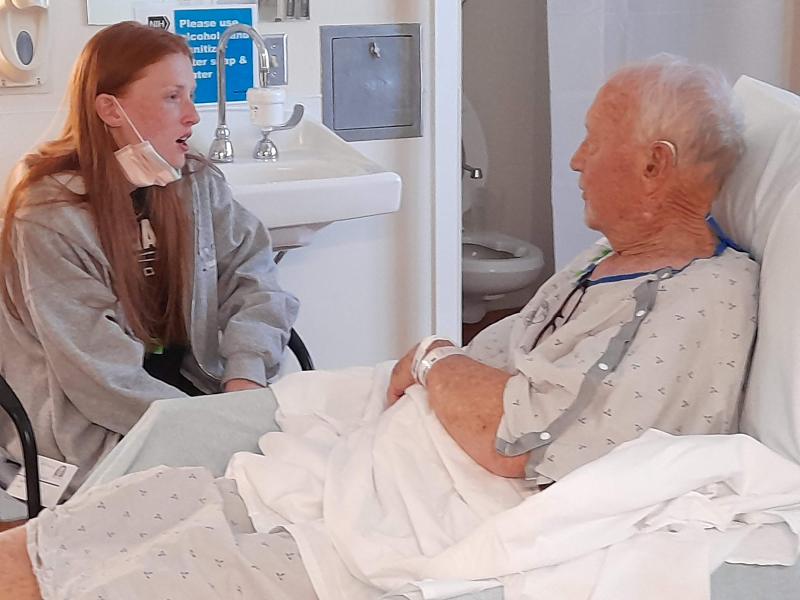A Roadmap to Improve Communication in the ICU

Three years ago, David Lunter came to the NIH as part of a lymphoma clinical trial. He didn't know at the time, but he was committing his remaining weeks to the VIPOR clinical trial study. While it did not help him, this protocol significantly extended the life of almost every participant and went on to also be used to treat more difficult cancers, with higher-than-expected success rates.
David’s wife, who came to accompany, support, and comfort, established a years-long relationship with the NIH Clinical Center focusing on communication with patients and their families.
Since that family's experience was mainly in the Intensive Care Unit (ICU), her outreach started there but led to participation in the NIH Clinical Center’s Patient Advisory Group (PAG). Through the PAG committee there are many insightful, committed, caring and reflective staff members who took the banner of excellence that characterizes this institution and are determined to raise it higher.
It might have been anticipated that a health care organization of international renown would look at the glowing family responses to everything they do well, every need they successfully meet, every survey with excellent ratings and say that's enough.
But rather than resting on laurels the staff listened, reflected, considered, discussed and formulated questions of their own. How can we heighten the level of connection to our patients and families? How can we consistently display the caring we feel? How can we keep our families fully informed? How can we offer meaningful two-way communication? Ultimately staff said, "Let's not be locked into our own views and assumptions."
Here are some of the results.
- Some of the changes have been straight forward. White Boards, for example, have long been used in patients' rooms. By adding daily goals, expected procedures and timelines for the day, the family can now clearly understand what to expect and when. All staff can use this tool to keep families informed. Likewise, the family is encouraged to add their wishes and requests for information to the board. They are asked directly if they want to participate in rounds and if so, that is noted on the white board and on the patient's door. To date about half the ICU families are taking advantage of the opportunity, a significant level of involvement.
- One of the most impactful innovations has been the addition of Purposeful Leadership Rounding, in which clinical managers and nurse managers join rounds, with the intention of introducing themselves to families and showing them how and where to use them as a resource. Contact is made with every family who will be in ICU for more than 72 hours. These leadership members communicate with most families weekly, during a multi-disciplinary meeting, but are proactive and reach out to the family if they hear about a problem. Additionally, they welcome the families to reach out to them as often as needed. One family even came back after the patient was no longer in the ICU to recount some positive experiences the staff had provided because so much of the communication while in care was focused on resolving the difficulties. This practice, which has been underway for about five months, helps to assure that families who need more support receive it.
- To further enhance communication between families and staff, the use of Family Diaries has been recently initiated. These are journals in which family members write their observations, questions, reflections and concerns. These daily accounts are shared with staff, including but not limited to nurses, physicians, social workers, therapists, and spiritual ministers. The diaries belong to the family and are not part of the medical record, thus encouraging, complete and honest communication and assuring confidentiality and patient/ family control of the writings. Currently, about 10 percent of families are using the diaries to share with staff. Of course, more might be keeping diaries for their own private reflection. For those engaged with communication through diaries it has proven to be extremely important. In one case, when a patient with three children died, the entire family kept and used their journal as a source of on-going comfort, a profound impact.
The recognition that an information void is frightening and that we need to listen to all credible comments has guided efforts to strengthen even already good communication. Thoughtful discussion, repurposing tools that are currently used, sharing best practices, and considering each patient's journey contributed to an increase in the amount and depth of communication.
The ideas implemented so far are being welcomed and used by families, which is helping them at their most vulnerable moments, providing the information they require, addressing their concerns and supporting their needs.
In keeping with the NIH commitment to excellence, conversations are already underway about how such appropriate and meaningful improvements might be disseminated widely. The ethic influencing this undertaking is what we want to know is enriched by what we need to know and the commitment to do a little better each day can result in improved care for patients and their families.
- Marcy Mager
Read Mager's previous essays:
Hard cases, compassionate care
Communication key to patient success